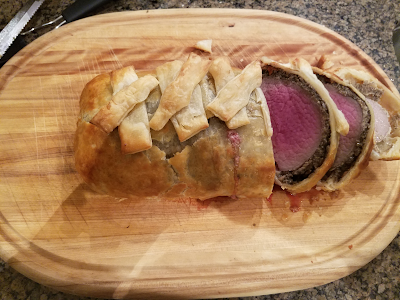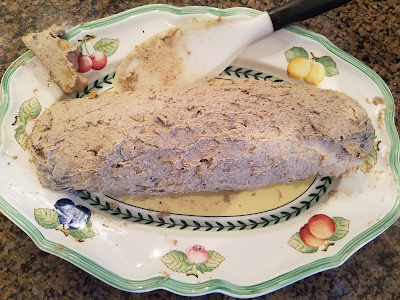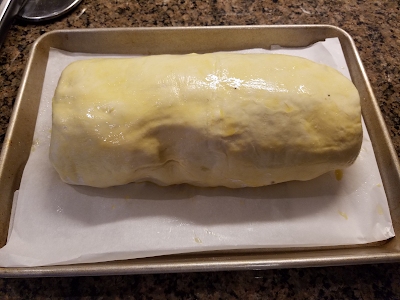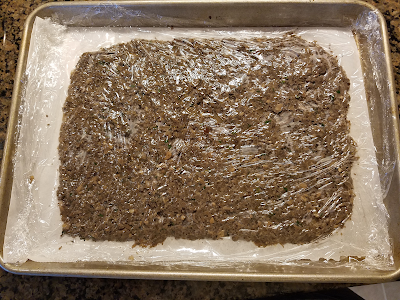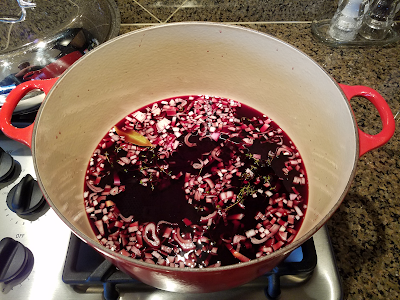It has taken a while for me to post the pictures and let you know how the Beef Wellington dinner came out. First, let me say the meal and the company was wonderful. We had a great time and because we had a plan for when everything had to happen, each course came out right on time and like clockwork. The photo above is of the main course dinner plate. It is Beef Wellington with a red wine sauce, roasted baby rosemary potatoes, and roasted asparagus.
We started the evening with drinks and a trio of bruschetta. They were Salmon with capers and creme fresh, fig jam, apple and brie, and goats cheese with tomato caper salad. Here is the tray with the three types of bruschetta.
Our next course was butternut squash ravioli in a sage brown butter sauce. We grated parmesan and bittersweet chocolate over the ravioli. I think it was really delicious and pretty on the plate, but I somehow missed getting a picture of that course. We served a nice crisp chardonnay with the ravioli.
Next we had the salad, which was spinach, apple and cheddar cheese with a maple syrup dressing. It was served with a Gewurztraminer that went very nicely with the sweetness in the salad dressing. The photographer (me) forgot to get a picture of that course too.
The main course came next. You saw the plate at the top of the post. Here is what the Beef Wellington looked like when I began to slice it. My pastry decorating looks a little like the laces on a football, but it tasted great. We served a Chateauneuf Du Pape with the beef.
Here is what the beef looked like after it was coated with the pate'.
And here it is in the puff pastry, right before it went in the oven.
Next up was a cheese course. It included just a small sample slice of six different cheeses. It seemed to be very popular and a surprise that we would have that course. We included three French cheeses including my favorite Blue, St. Agur, along with La Petite Brie and Pave' Du Nord. We also had Cotswold, an English Gloucester with onion and chives and an Irish Cheddar with whiskey. We had one American cheese, which was Humboldt Fog, a California goat's cheese with a stripe of edible vegetable ash running through it. The cheese plates had a little swirl of honey, and some walnuts and raspberries. We continued to drink the dinner red wine with the cheese. The cheese servings looked like this:
As a final course we had honey poached pears. The pear was served with a Missouri Ice Wine called Augusta, which was delightful with the pear and honey.
Now to the not so good an ending. Our guests left around 10:30 or 11:00. Jan and I were cleaning up the dishes and the kitchen. Our sink started to gurgle although it was still draining. I happened to look out in the entry hall of the condo and had a very unpleasant surprise. The contents of the disposal seemed to be leaking out of the furnace closet door and all over our carpet. The sewer line leading from the sink runs under the floor and under the heating system, which is in a closet off the entry hall. There is a floor drain under the heating system. Apparently there was a clog in the line somewhere out in the hall leading to the condo. When the waste from the sink and disposal got to the clog they backed up through the floor drain and into the condo. I called a plumber who arrived at 1:00 AM and left at 2:30. We got to bed at 3:30 and ever since have been dealing with the cleanup, including having baseboard removed, fans running for 24x7 for four days, carpets cleaned, drywall repair where the baseboards were removed and repainting. We hope the conteractor will have the work done by Tuesday or Wednesday.
This dinner party will be remembered not only for the good food and company but also for the ending, which as you can now see was not so good.


